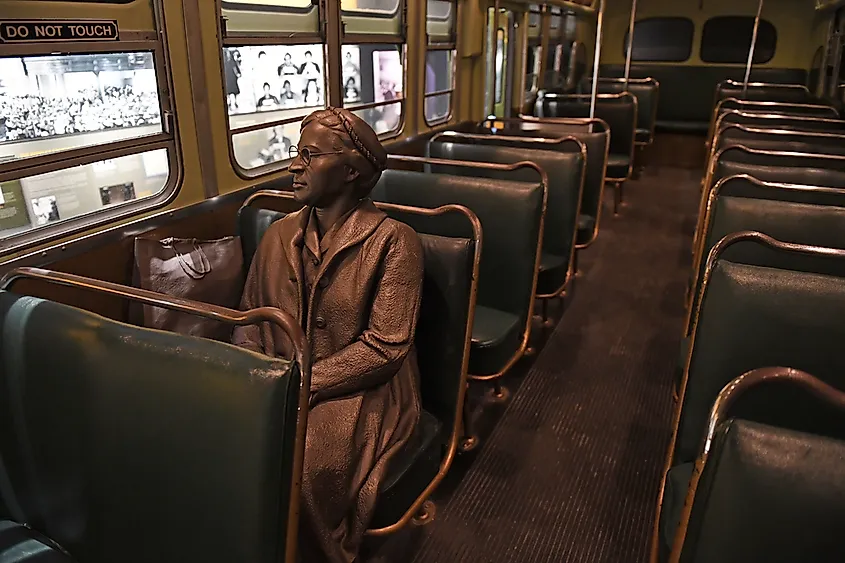How Did Rosa Parks Change The World?

Rosa Parks was a famous activist during the civil rights movement of the 1950s and 1960s in the United States. She is most well known for the role she played in the Montgomery bus boycott. She chose not to give up her seat on the bus to a white man when public transportation was racially segregated by law.
Rosa Parks chose to be arrested instead of giving up her seat and became a symbol of the fight against an unjust, racist system. She was nicknamed “the first lady of civil rights” by the U.S. Congress.
The Early Life And Activism Of Rosa Parks
Rosa Parks was born in 1913 (February 4), in Tuskegee, Alabama. Her maiden name was McCauley. During her childhood, she suffered from poor health and had attended mostly rural schools. Around this time, racial segregation was becoming more prevalent in the south of the United States. This was due to the former Confederate states adopting laws that took away the voting rights from black people. Public transportation had separate seating sections for blacks and whites, and school buses were unavailable for black children. In her autobiography, Parks remembered the members of the Ku Klux Klan marching in front of her house. She was often bullied by white children and had to fight back.
In 1932, Rosa married Raymond Parks, who was a member of the National Association for the Advancement of Colored People (NAACP). She was working numerous jobs and managed to finish her high school studies in 1933. She started being more active in the civil rights movement in 1943 when she began working as a secretary for the NAACP. While working there, she investigated cases of racial injustice and campaigned for equality. In the 1940s, she worked at an air force base for a while, and because it was federal property, there was no racial segregation there, which was an eye-opening experience for Parks.
The Montgomery Bus Boycott
In August of 1955, Emmett Till, a black teenager, was mercilessly murdered in Mississippi by racists. That event started stirring a larger uprising of the civil rights movement, the murderers were acquitted, and the case garnered a lot of media attention. This event incredibly saddened Rosa Parks. On Thursday, December 1, 1955, she boarded the bus in downtown Montgomery and sat in the first row of the seats reserved for blacks, the so-called “colored section.” The bus began to fill up, and soon the driver asked the black passengers to give up their seats for white people and move to the back of the bus.

Rosa Parks continuously refused to stand up and give up her seat. According to her, she remembered Emmett Till and couldn’t go back. She was arrested after the driver called the police. It is often believed that Rosa Parks couldn’t stand up because she was physically tired; however, this is not true, and Parks disputed it herself. After her arrest and release, the members of the NAACP started to plan a bus boycott. The boycott aimed to force the predominantly racist society to treat blacks with the normal level of respect and courtesy, to hire black drivers and for the middle row of the bus seats to be open for those that sit there first.
Rosa Parks was found guilty on trial. However, she decided to take a stand and appeal her conviction, thereby challenging racial segregation through legal means. The boycott continued, and a new group was formed to continue leading it. The name of the group was the “Montgomery Improvement Association” (MIA), and its first president was Martin Luther King Jr., who was still unknown then. 17,000 people joined the boycott, and 13 months later, the buses were desegregated.
The Impact And Importance Of Rosa Parks
The actions of Rosa Parks played an enormous role in the fight for civil rights. She was a model citizen, employed, married, and well versed in politics, which made her the perfect choice for the attempt to fight segregation laws. Her actions helped raise international awareness of racism in the United States. Her arrest is considered to be the catalyst that fueled the civil rights movement. Although what she did may seem like something insignificant to the younger generations of today, it was an astonishingly brave thing to do, and it changed the entire world for the better.
The fight against racism is still ongoing, but people like Rosa Parks are responsible for making it grow to a tremendous size. She became an absolute icon because of what she did and is rightfully considered “the mother of the civil rights movement.”











